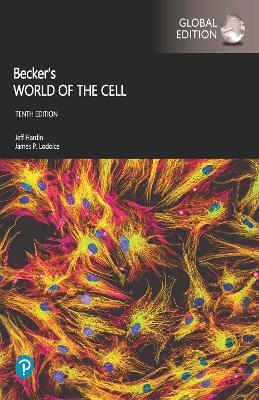
Mastering Biology without Pearson eText for Becker's World of the Cell, Global Edition
Pearson Education Limited (Hersteller)
978-1-292-42657-0 (ISBN)
Connectingfundamental concepts across the world of the cellKnown for its strong biochemistry coverage and clear, easy-to-followexplanations and figures, Becker’s World of the Cell provides abeautifully illustrated, up-to-date introduction to cell biology concepts,processes, and applications. Informed by years of classroom experience in thecell biology course, the text features accessible and authoritativedescriptions of all major principles, as well as unique scientific insightsinto visualization and applications of cell and molecular biology. With the 10thEdition, the authors guide students to make connections throughout cellbiology, and provide questions that encourage students to practice interpretingand analyzing data. Embedded features in Pearson eText add interactivity,walking students through key figures with narrated explanations.
Personalizelearning with Mastering Biology with Pearson eText
Mastering® empowers youto personalize learning and reach every student. This flexible digital platformcombines trusted content with customizable features so you can teach yourcourse your way. And with digital tools and assessments, students become activeparticipants in their learning, leading to better results.
PearsoneText is an easy-to-use digital textbook available within Mastering that letsstudents read, highlight, take notes, and review key vocabulary all in oneplace. If you’re not using Mastering, students can purchase Pearson eText ontheir own or you can assign it as a course to schedule readings, view studentusage analytics, and share your own notes with students.
JEFFHARDIN received his Ph.D. in Biophysics from the University ofCalifornia–Berkeley. He is the Raymond E. Keller Professor and Chair of theDepartment of Integrative Biology at the University of Wisconsin–Madison, wherehe has been since 1991. For 18 years he was Faculty Director of the BiologyCore Curriculum, a four-semester honors biology sequence for undergraduates atWisconsin known for its teaching innovations. Jeff ’s research focuses on howcells migrate and adhere to one another during early embryonic development.Jeff ’s teaching is enhanced by his extensive use of digital microscopy and hisweb-based teaching materials, which are used on many campuses in the UnitedStates and in other countries. Jeff was a founding member of the UW TeachingAcademy, and has received several teaching awards, including a Lily TeachingFellowship, a National Science Foundation Young Investigator Award, and aChancellor’s Distinguished Teaching Award. JAMES P.LODOLCE earned his Ph.D. in Immunology from the University of Chicago in2002. His thesis examined the signals that promote the survival of memory lymphocytes.As a postdoctoral fellow in the laboratory of Dr. David Boone, he studied thegenetics and regulation of inflammation in autoimmunity. Cell biology was thefirst class that James taught when he arrived at Loyola University Chicago in2010. He currently holds the title of Senior Lecturer and teaches a variety of coursesranging from molecular biology to virology. James is an active member of theDepartment of Biology and was appointed Co-Chairperson of Loyola’s 2021 Pre-HealthProfessions Advisory Committee. In his career at Loyola, James has receivedseveral teaching honors, including a nomination for the 2014 Ignatius LoyolaAward for Excellence in Teaching, the 2016 Master Teacher Award in the Collegeof Arts and Sciences, and the 2020 Edwin T. and Vivijeanne F. Sujack Award forTeaching Excellence.
1. A Preview of Cell Biology
2. The Chemistry of the Cell
3. The Macromolecules of the Cell
4. Cells and Organelles
5. Bioenergetics: The Flow of Energy in the Cell
6. Enzymes: The Catalysts of Life
7. Membranes: Their Structure, Function, and Chemistry
8. Transport Across Membranes: Overcoming the Permeability Barrier
9. Chemotrophic Energy Metabolism: Glycolysis and Fermentation
10. Chemotrophic Energy Metabolism: Aerobic Respiration
11. Phototrophic Energy Metabolism: Photosynthesis
12. The Endomembrane System and Protein Sorting
13. Cytoskeletal Systems
14. Cellular Movement: Motility and Contractility
15. Beyond the Cell: Cell Adhesions, Cell Junctions, and Extracellular Structures
16. The Structural Basis of Cellular Information: DNA, Chromosomes, and theNucleus
17. DNA Replication, Repair, and Recombination
18. Gene Expression: I. Transcription
19. Gene Expression: II. The Genetic Code and Protein Synthesis
20. The Regulation of Gene Expression
21. Molecular Biology Techniques for Cell Biology
22. Signal Transduction Mechanisms: I. Electrical and Synaptic Signaling inNeurons
23. Signal Transduction Mechanisms: II. Messengers and Receptors
24. The Cell Cycle and Mitosis
25. Sexual Reproduction, Meiosis, and Genetic Recombination
26. Cancer Cells
Appendix: Visualizing Cells and Molecules
| Erscheint lt. Verlag | 13.4.2022 |
|---|---|
| Verlagsort | Harlow |
| Sprache | englisch |
| Themenwelt | Naturwissenschaften ► Biologie ► Genetik / Molekularbiologie |
| Naturwissenschaften ► Biologie ► Zellbiologie | |
| ISBN-10 | 1-292-42657-8 / 1292426578 |
| ISBN-13 | 978-1-292-42657-0 / 9781292426570 |
| Zustand | Neuware |
| Informationen gemäß Produktsicherheitsverordnung (GPSR) | |
| Haben Sie eine Frage zum Produkt? |